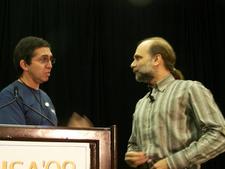USENIX LISA: Security Theater Plays a Role - Bruce Schneier's Keynote
The opening keynote Thursday of the USENIX LISA conference in San Diego was by author and security expert Bruce Schneier. In his opinion "perceived security" should be an aspect of all security implementation.
The large conference room was packed at Schneier's presentation, "Reconceptualizing Security." In one of his first slides, he pointed out that security has always been one of the basic human instincts by showing the part of the brain known as the amygdala where the emotion of fear (and its opposite, security) is seated. Schneier joked that "the newer part of the human brain responsible for heuristics is still in beta." He undermined the discrepancy between subjective feelings and provable facts with a few examples. Deviating from his slides and presentation material, he relied mainly on his words and gestures. "Security is at one time feeling and reality," according to his thesis, "You can feel safe without actually being safe, and you can feel unsafe for no apparent reason."
Schneier applied his thesis to a phenomenon he called "security theater." As an example he used the safety screw cap, designed to quell any fear that the content of the bottle might have been tampered with. He could think of at least ten ways that the content could be compromised, mentioning a syringe for one. Nevertheless, tamper-proof bottles provide an objective sense of security, which proved a saving grace for the medication industry after some well known poisoning incidents. Schneier felt that "as technicians, we kid ourselves that the security for which we're responsible is reliabable. That isn't true. We forget that humans play a major role."
Ignoring the emotional part of security is wrong in Schneier's judgment, and he advises technicians to incorporate the "security theater" concept in their work. Responding to a question about statistics, he suggested that they have little effect: "People who know statistics think they work better, but they don't." According to him, security models should adhere closely to reality, while recognizing that reality is mutable. His conclusion: "It's only when the feeling and the reality of security converge that we have real security."
Subscribe to our Linux Newsletters
Find Linux and Open Source Jobs
Subscribe to our ADMIN Newsletters
Support Our Work
Linux Magazine content is made possible with support from readers like you. Please consider contributing when you’ve found an article to be beneficial.

News
-
Linux Servers Targeted by Akira Ransomware
A group of bad actors who have already extorted $42 million have their sights set on the Linux platform.
-
TUXEDO Computers Unveils Linux Laptop Featuring AMD Ryzen CPU
This latest release is the first laptop to include the new CPU from Ryzen and Linux preinstalled.
-
XZ Gets the All-Clear
The back door xz vulnerability has been officially reverted for Fedora 40 and versions 38 and 39 were never affected.
-
Canonical Collaborates with Qualcomm on New Venture
This new joint effort is geared toward bringing Ubuntu and Ubuntu Core to Qualcomm-powered devices.
-
Kodi 21.0 Open-Source Entertainment Hub Released
After a year of development, the award-winning Kodi cross-platform, media center software is now available with many new additions and improvements.
-
Linux Usage Increases in Two Key Areas
If market share is your thing, you'll be happy to know that Linux is on the rise in two areas that, if they keep climbing, could have serious meaning for Linux's future.
-
Vulnerability Discovered in xz Libraries
An urgent alert for Fedora 40 has been posted and users should pay attention.
-
Canonical Bumps LTS Support to 12 years
If you're worried that your Ubuntu LTS release won't be supported long enough to last, Canonical has a surprise for you in the form of 12 years of security coverage.
-
Fedora 40 Beta Released Soon
With the official release of Fedora 40 coming in April, it's almost time to download the beta and see what's new.
-
New Pentesting Distribution to Compete with Kali Linux
SnoopGod is now available for your testing needs

